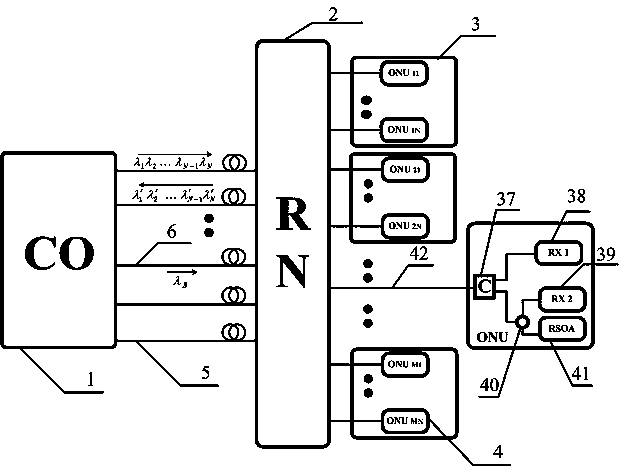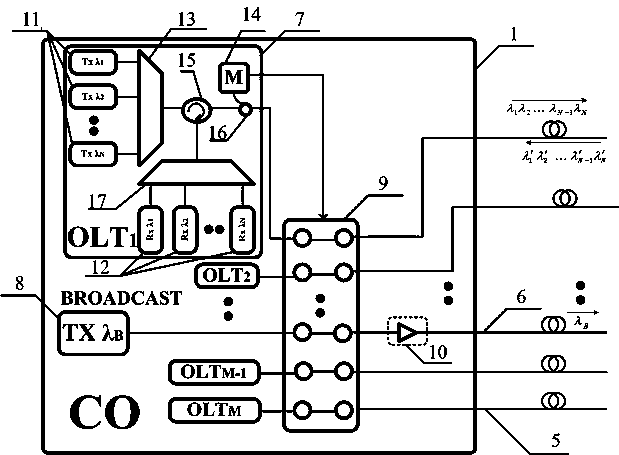Large-scale optical access network system and method for realizing transmission and protection functions of broadcasting services in wavelength division multiplexing optical access network
A broadcasting service and access network technology, applied in the field of optical communication, can solve problems such as inability to directly realize broadcasting service transmission
- Summary
- Abstract
- Description
- Claims
- Application Information
AI Technical Summary
Problems solved by technology
Method used
Image
Examples
Embodiment 1
[0023] see figure 1 , this WDM optical access network is a large-scale optical access network system that realizes the transmission and protection functions of broadcasting services. The central office CO (1) connects a remote node RN through M+1 single-mode optical fibers (2), the remote node RN (2) is connected to M optical network unit groups (3) through distributed optical fibers, and each optical network unit group includes N optical network unit ONUs (4).
[0024] see figure 2 , the central office CO (1) includes a broadcast signal transmitter (8), M optical line terminals OLT (7), an M+1 M+1 optical switch (9) and an optional first erbium-doped fiber amplifier EDFA (10), wherein each optical line terminal OLT (7) contains N optical signal transmitters (11), N optical Signal receiver (12), first and second two 1*N arrayed waveguide gratings AWG (13, 17), an optical circulator (15), an optical signal monitor (14), a first optical branch device (16). In the OLT (7), ...
Embodiment 2
[0028] see figure 1 , figure 2 , image 3 The specific method of the system shown in the large-scale optical access network that realizes the transmission and protection functions of the broadcasting service of the system wavelength division multiplexing optical access network is: for the transmission of the broadcasting service, firstly, the The transmitter (8) uses a specific and exclusive wavelength for broadcast signal transmission, after the optical signal is amplified by a first erbium-doped fiber optical amplifier EDFA (10), it passes through an M+1 The M+1 optical switch (9) is sent into the shared optical fiber (6) and transmitted to the remote node RN (2). In the remote node RN (2), the broadcast signal in the shared optical fiber (6) first passes through a fourth erbium-doped fiber optical amplifier EDFA (28) for signal amplification and then passes through a third coarse wavelength division multiplexer (29 ) to send the broadcast optical signal with the above w...
Embodiment 3
[0030] see Figure 4 , Figure 5 , when any one of the M feeder fibers (5) fails, 1:M shared protection can be performed through the shared fiber (6). When a fault occurs, the optical signal monitor (14) located in the optical line terminal OLT (7) in the central office CO (1) detects the change of the upstream optical signal, and controls M+1 The optical switch (9) of M+1 puts the network into protection mode. The uplink and downlink signals originally in the faulty feeder fiber (5) pass through M+1 The switching of the optical switch (9) of M+1 is loaded onto the shared optical fiber (6) and transmitted together with the broadcast signal. At the same time, the optical signal monitor (19) in the REPEATER repeater (18) connected to the faulty feeder fiber (5) in the remote node RN (2) detects the change of the downlink optical signal, and controls 1 The light switch (20) of 2 makes it enter protection mode. In this way, the optical signal carrying the downlink informat...
PUM
 Login to View More
Login to View More Abstract
Description
Claims
Application Information
 Login to View More
Login to View More - R&D
- Intellectual Property
- Life Sciences
- Materials
- Tech Scout
- Unparalleled Data Quality
- Higher Quality Content
- 60% Fewer Hallucinations
Browse by: Latest US Patents, China's latest patents, Technical Efficacy Thesaurus, Application Domain, Technology Topic, Popular Technical Reports.
© 2025 PatSnap. All rights reserved.Legal|Privacy policy|Modern Slavery Act Transparency Statement|Sitemap|About US| Contact US: help@patsnap.com



